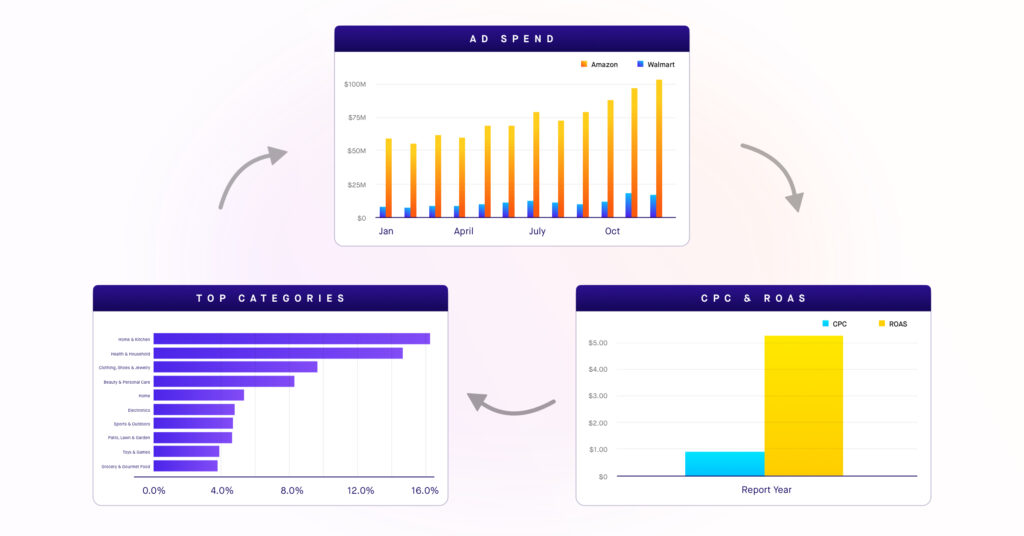Ecommerce consumer research is easier than ever now that you can crowd-source it online.
Testing and measurement help you be a better seller. This concept applies when you’re choosing product images, making social posts, modifying Amazon listings, and managing other pieces of your ecommerce business – you need to find and optimize to what will convert best.
In this webinar, Justin Chen, Co-Founder of PickFu, joins Teikametrics’ Andrew Waber for a great discussion about the power of the hive mind, and how 10,000 opinions can help you gain the competitive edge.
Here’s what we cover:
- Benefits to involving real shoppers in your product decisions
- How real opinions can help you position your brand in the best light
- What you can learn from real people about your marketing, packaging, and more
- Real-life examples of sellers and brand owners who win on Amazon with the right data
Show notes
- Follow Justin Chen, Co-Founder, PickFu
- Follow Andrew Waber, Director of Insights, Teikametrics
Watch the crowd-sourced ecommerce consumer research webinar on-demand
Webinar highlights
Andrew and Justin shared tips and tools that sellers need to succeed on marketplaces by gathering and applying consumer research. Read the webinar highlights, including Andrew’s predictions on brand building and Justin’s take on what sellers are already getting right.
Use Amazon Stores to build your brand presence on the marketplace
Andrew talked about the value of building a brand experience on Amazon by using the Amazon Store strategically. Use it to tell your brand story and as a landing page for Sponsored Brands ads.
“Let’s talk about Storefront. On Amazon, this is super important. You’re going to see more and more retailers do stuff around this. You are seeing Walmart already put this into action. But even just focusing on Amazon, the biggest thing here is, if you’re a brand selling on Amazon, this should be a really high priority for you to make a really nice experience here.” -Andrew Waber
Follow these tips to win on Amazon
Andrew talked through four aspects of retail readiness that will keep your brand strong on Amazon:
- Always stay in stock
- Work to win the Buy Box
- Have great product imagery
- Utilize A+ content
“Consumers need validation. Product imagery helps with that. And that doesn’t just mean I’m going to have one product shot, and of the front and the back, and that’s it. The motivation for these consumers is going to be very different depending on a product category or even within your product category. What will motivate different consumers? It might be a very detailed product shot that shows very detailed notes about exactly what’s on the packaging. It may include lifestyle imagery that shows how you use the product. It may include text overlaid on the imagery that just shows, hey, here are potential uses that kind of lays them out. There’s any number of different image styles that you can use here.” -Andrew Waber
Lock in the four “Do’s” of Retail Readiness
Andrew also covered four “do’s” of retail readiness:
- Understand the attributes you need to spell out in your listings
- Have consistent branding between marketplaces
- Go beyond the basic listing requirements when launching a product
- Ensure you meet all seller performance requirements
“Consistency is important. It’s not to say that you want to have an identical presence across each and every marketplace. But you want to have consistency in the product imagery. What you don’t want is someone going to your website, they see a completely different product than what you’ve got on Amazon. You want to instill trust.” – Andrew Waber
Avoid ecommerce pitfalls
Andrew warned against common pitfalls: Don’t jump into a new marketplace with lingering questions about inventory levels. Don’t port over product details from one channel to another without adapting. Don’t expect immediate success.
“When you get your product live, expecting immediate success is not going to be realistic. You have to have this longer view in terms of what’s going to be a success for you as a brand…Nothing is static on Amazon, or these marketplaces in general. There are always new competitors coming in. There’s always changes to the algorithm that you may not expect. There’s changes in the supply chain or changes to fulfillment. And you need to be constantly adjusting to those changes.” -Andrew Waber
Keep listening to customer feedback
Justin pointed out that sellers already have and use many tools to learn from shopper feedback. This includes reviews, returns, and questions from customers.
“Winning sellers already know that you win by listening to your customers. There’s probably a bunch of human feedback that you’re already getting, and you’re paying attention to. You’re looking at your listings, making sure you answer every question that someone posts. You’re responding to reviews, you’re asking for more reviews, and then you’re digging deep into why people are returning your product. And so, all of this is super valuable information from your existing customers. Definitely keep doing that.” -Justin Chen
But it’s even better to do consumer research before you go to market
Justin says all the ways of listening to customer feedback are important, but if the feedback is negative it may be too late to win the loyalty of that customer. However, you can start to get feedback even before bringing a product to market, so you can better anticipate shopper reactions and needs.
“The great thing about crowdsourcing your data is that you can involve shoppers much earlier in your process. So your product doesn’t even have to necessarily be ready for sale yet, before you can start gathering feedback. And in fact, it’s actually better to start testing at that stage, because then you actually have time to course-correct, in case something’s not resonating with your audience. So the more that you can anticipate what shoppers want, the more of a competitive edge that you’re going to have. So get the shoppers involved early before you even start selling, and you’re going to have a lot more confidence when you go to market.” -Justin Chen
You can gather that consumer research with PickFu
PickFu can help you to get that feedback from your target audience before you finalize the product and bring it to market.
“It’s a website that essentially acts like an online focus group. So in a PickFu poll, you ask a single question. This question can be about anything. It could be about your ideas, or a product design or feature, even a product packaging concept. And what happens is, we have a group of over 10,000 U.S. respondents that we call the PickFu Panel. And they’re ready to provide instant, written, honest feedback within a matter of minutes, with some of those posts finishing within 30 minutes or an hour. The feedback that they provide can actually guide how you develop and market your products so that you use data to make better decisions.” – Justin Chen
Use feedback for competitive research
One valuable thing you can do is get shopper feedback comparing your product to your competition. That makes shopper input part of your competitive research.
“The name of this session is Crush Your Competition. Asking customers when you’re evaluating the competition is a really effective way to do that. With PickFu, you can actually put your product up against your competitor in a completely private environment. This is totally off Amazon, this is not running anything live. People will tell you directly why they would or wouldn’t choose your product, over the other one in this kind of synthetic environment.” – Justin Chen
Want more branding tactics?
As you think through how to use consumer research to inform product development and branding, you may want to go deeper on ecommerce branding strategies.
Check out Painless Branding For Amazon Sellers, a conversation between our own Cameron Yoder and Emma Schermer Tamir of Marketing By Emma.




